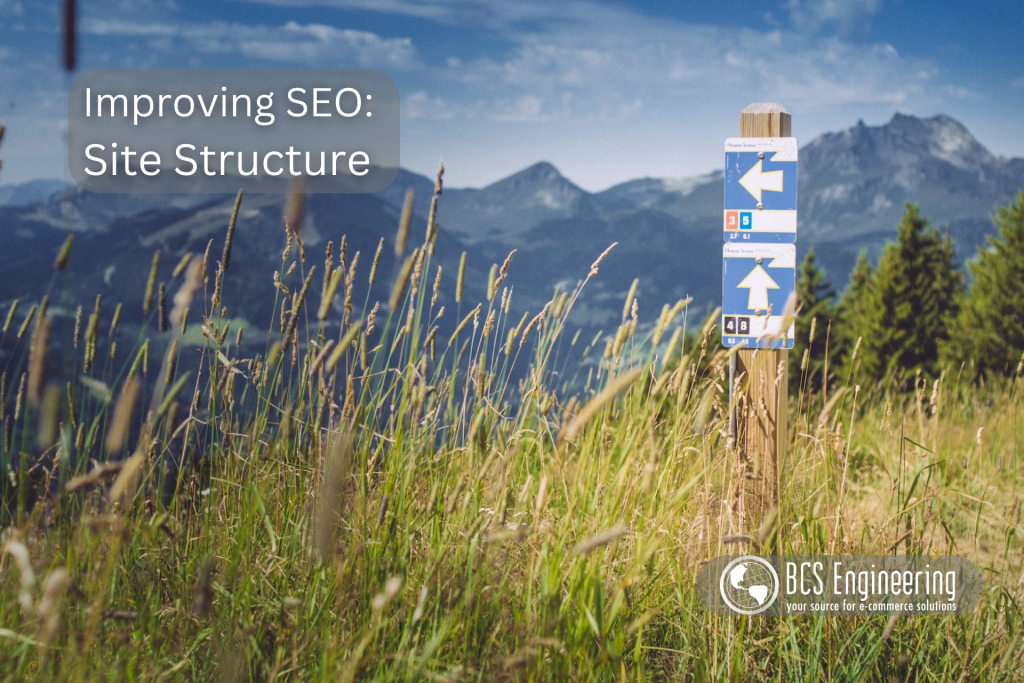In previous articles, we have explored a variety of ways to improve On-Page Search Engine Optimization (SEO). From page speed to the content itself, there are many ways to approach increasing your site’s ranking in the eyes of search engines. Another aspect that is important to both SEO and general user experience is your site’s structure.

What is Site Structure?
Site structure is the way your content is organized. From product pages to blog posts, where these pieces of content are and how people navigate to them are determined by your site’s structure. Any linkage in your site plays a role in guiding users to your content. A few major aspects to your site structure are:
- Taxonomies – taxonomies are the way in which your site classifies its content. They group related content by using categories and tags. Taxonomies aid users in finding the content they want and help Google properly index your website.
- Navigation Menus – Navigation menus are usually the collection of tabs at the top of a site that guide users to other content. Easy to understand categories and neatly arranged sub-menus aid in bringing users to more content without overwhelming them.
- Internal & External Linkage – Internal links are hyperlinks that guide users to more content within your site. External links lead users to material you deem useful that is outside of your site. These links keep users engaged longer and also help Google understand your focus, increasing your visibility.
- Breadcrumbs – A breadcrumb is a text path located at the top of a page that identifies where users are on your site. An example of a breadcrumb would be Home > Blogs > Site Structure. While simple, breadcrumbs help both users and Google understand your site’s structure and easily backtrack to explore more of your content.
How does Good Site Structure Benefit my Site?
The main goal of quality site structure is to make it easier for both your users and Google to find your best content. For Google, site structure helps guide their bots to your most important content. Via your links, Google will navigate your pages in an attempt to understand your business. This content should help Google understand what you site is about and what you specialize in. The easier Google can explore and interpret your site, the more likely your SEO rank will increase.
If Google deems that your site performs well, usually your users share the same sentiment. Good site structure means that users can easily find the content they want. With proper linkage, you can guide your users to your most relevant content, helping them find solutions to the problems they came here to solve. Improved SEO and good user experience are key to increasing your traffic and conversions.
How do I Improve my Site Structure?
Prune your Content
Content pruning is the process of removing content that is no longer relevant. Such content could out of date, uninteresting to your users, or too similar to existing content. As your site grows, so will the number of blogs and pages you have, and that means it can become overwhelming for users to find your most important content. Cut content that you deem is unnecessary in order to de-clutter your site.
Note: Remember to Use Redirects
Your pages and blogs were all made with some purpose in the beginning and may be linked to other existing content. May sure to redirect the links on content you decide to remove to better content that fulfills a similar purpose. Broken links are a quick way to lose users.
Optimize Navigation & Taxonomies
Navigation and taxonomies are places where too much content can become overwhelming. Too much content makes it harder for both users and Google to understand what they should be looking at. We want to guide both visitors and search engines to our best pages and blogs. To do this, we need to make sure that no category in our navigation menu or in our taxonomies is too much bigger than the others.
Note: Don’t Overfill your Categories
A good rule of thumb to follow for both your navigation bars and your taxonomies is to make sure that no category is more than twice the size of another. This means that, for your navigation bar for example, no tab should have a much longer sub-menu than the other. For your taxonomies, this means a category shouldn’t contain the majority of your content, but instead be divided into smaller, more palatable collections.
Improve Internal Linking
By putting internal links into an article or page, you are telling your users and Google that this content is important and relevant. Internal links can help keep users on your site by giving them easy avenues to access more content that is similar to what they already read. By strategically placing internal links, you will keep you users engaged longer and aid Google in understanding the relationship between your content.
Note: Consider Link Value when Inserting an Internal Link
As Google explores your internal links, it also determines link values. Link values are determined by the location of the link. For example, your homepage tends to have the most link value due to it having the most back-links to it. So, if you link your blog article to your homepage, that link will be considered more valuable than if you linked it somewhere else. This helps Google find your most important content faster.
Want to Learn More?
Improving your SEO is a continuous process that will require consistent maintenance as your site grows and SEO requirements change. The same can be said for your website as a whole. Carrie Saunders’ upcoming course, “The Converting Website,” will dive into SEO and other important factors that aim to optimize your website. Join the waitlist today to stay up to date on the classes release!
